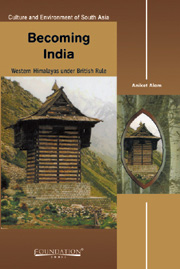Book contents
- Frontmatter
- Contents
- Preface
- Glossary
- Map
- Chapter 1 The Geography of the Western Himalayas
- Chapter 2 Political Economy of the Western Himalayas: Early Nineteenth Century
- Chapter 3 The Foundations of British Rule: Hill State, Hill Station, Land Settlement and Monetisation
- Chapter 4 Peasant Rebellions and Royal Reconciliation: British Rule inside the Hill States
- Chapter 5 Social Movements during British Rule
- Chapter 6 After Independence
- Conclusion
- Bibliography
- Index
Chapter 1 - The Geography of the Western Himalayas
Published online by Cambridge University Press: 26 October 2011
- Frontmatter
- Contents
- Preface
- Glossary
- Map
- Chapter 1 The Geography of the Western Himalayas
- Chapter 2 Political Economy of the Western Himalayas: Early Nineteenth Century
- Chapter 3 The Foundations of British Rule: Hill State, Hill Station, Land Settlement and Monetisation
- Chapter 4 Peasant Rebellions and Royal Reconciliation: British Rule inside the Hill States
- Chapter 5 Social Movements during British Rule
- Chapter 6 After Independence
- Conclusion
- Bibliography
- Index
Summary
The Himalayas have been an integral part of the geographical knowledge of Indian civilisations since at least the Vedic period. Their significance as cultural and religious icons and as the source of the perennial rivers of the North Indian plains, which sustained its agriculture and human settlements, was recognised from the earliest times. Their importance as a line of defence and as a defining physical boundary separating India from its neighbours to the north and the east was also acknowledged. This knowledge of the Himalayas was not confined to the peoples of the Indo-Gangetic plains but got diffused till the southern most corner of the peninsula as early as the period of the Sangam Literature. This knowledge remained for most of the historical period merely as ‘knowledge of the Himalayas’ and could not become ‘knowledge about the Himalayas’ till the coming of the British and their conquest of the Western Himalayas in 1815. Even after so many years ‘knowledge about the Himalayas’ has remained perfunctory, scattered and slow in its spread within the educational and policy-making institutions of India. It is still common to find generalisations made on the basis of geographical contexts which are alien to the region.
Therefore, this chapter has two purposes. The first is to describe and define the topographical, climatic and other natural aspects of the Western Himalayas, which make it a unique ecological niche of the South Asian region. This will enable a fuller understanding of the various social and economic processes, which followed the consolidation of British rule.
- Type
- Chapter
- Information
- Becoming IndiaWestern Himalayas under British Rule, pp. 1 - 31Publisher: Foundation BooksPrint publication year: 2007



